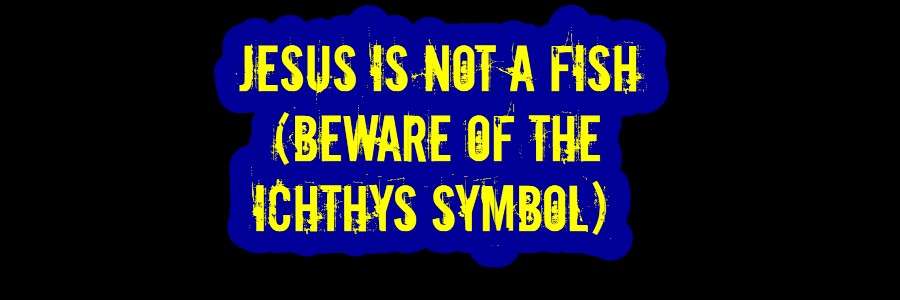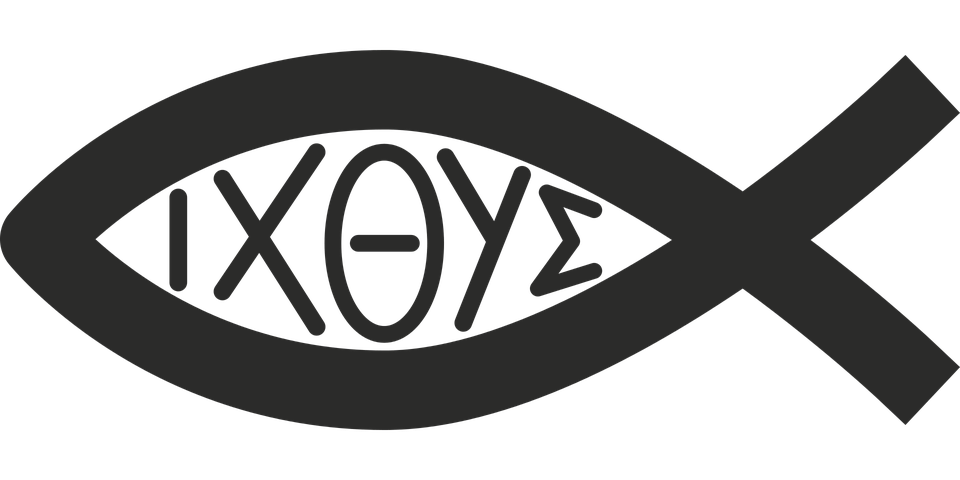
Jesus is Not a Fish (Beware of the Ichthys Symbol)
Anyone who is not familiar with the Ichthys symbol off the top of their head has probably still seen it before. It can be found easily online if you don’t know what I’m talking about. “Ichthys” is the word used in Greek in the New Testament for fish. The Ichthys symbol is an image of a fish which came to commonly be used to represent Jesus Christ.

It is wise to question the origin of any symbol which people have connected to Christianity. There is also wisdom and safety in refraining from the use of religious symbols altogether.
However, the Ichthys symbol should especially be scrutinized due to how it is supposed to represent Jesus Christ Himself while it is also unquestionably sin to represent God improperly (and of course Jesus is God as the 2nd person of the Trinity).
In warning Israel about departing from Him, and citing making a graven image as a chief way of doing this, God made it clear that visually portraying Him- including through the depiction of an animal- is indeed a form of idolatry which provokes Him to jealousy.
Note also here that representing God through a fish is even specifically cited in the following warning.
Deuteronomy 4:15-19 and 23-24: “Take ye therefore good heed unto yourselves; for ye saw no manner of similitude on the day that the Lord spoke unto you in Horeb (Mount Sinai) out of the midst of the fire: Lest ye corrupt yourselves, and make you a graven image, the similitude of any figure, the likeness of male or female, The likeness of any beast that is on the earth, the likeness of any winged fowl that flieth in the air, The likeness of any thing that creepeth on the ground, the likeness of any fish that is in the waters beneath the earth: And lest thou lift up thine eyes unto heaven, and when thou seest the sun, and the moon, and the stars, even all the host of heaven, shouldest be driven to worship them, and serve them, which the Lord thy God hath divided unto all nations under the whole heaven….(moving ahead now to Deuteronomy 4:23) Take heed unto yourselves, lest ye forget the covenant of the Lord your God, which he made with you, and make you a graven image, or the likeness of any thing, which the Lord thy God hath forbidden thee. For the Lord thy God is a consuming fire, even a jealous God.”
This study could be ended right here since God commanded not to represent Him through any likeness- even going out of His way to specifically mention representing Him through a fish as a means of provoking His jealousy and incurring His wrath.
It is also notable that Pagans had already used fish in their worship as a symbol of fertility prior to Christ’s time. It is even commonly thought that the Philistine god Dagon was a half man, half fish creature. We see in 1 Samuel chapter 5 that the house of Dagon is where the Philistines took the Ark of God to after they had captured it.
One quote that those who want to defend using the Ichthys symbol might resort to is from Tertullian (who lived in the late 2nd century and early 3rd century AD). This quote called Christians little fishes and referred to Jesus as their Ichthys (as if He is the great fish and His disciples are little fishes).
But just because Tertullian used this analogy does not make it valid.
Jesus is never compared to a fish in the Bible. The Bible certainly forbids images representing God as well as forbidding copying Pagan imagery for use in His worship.
You can’t justify the Ichthys symbol because Tertullian and other so-called “early church fathers” didn’t heed that.
The fact that the word Ichthys can be used to make an acrostic which says “Jesus Christ Son of God Savior” in Greek doesn’t validate the Ichthys symbol. Acrostics with Christian messages could be made from many different words.
The stories of early Christians drawing the Ichthys symbol to identify other Christians are very general.
The Ichthys symbols in underground catacombs used by Christians don’t necessarily prove anything more than that corruption had set in among the churches in the centuries following the lives of Christ and His Apostles. That is already known anyways and can be demonstrated in many other ways as well.
It’s interesting how an unbiblical fish symbol remains prevalent until today while another thing which can be proven by the same catacombs is commonly discarded- Christian women wearing head coverings.
Yet in promoting head covering it would still be unwarranted to resort to the catacomb images to claim that women ought to cover their heads. Head covering should rather be promoted because it can be demonstrated from Scripture.
1 Corinthians 11:6-7: “For if the woman be not covered, let her also be shorn: but if it be a shame for a woman to be shorn or shaven, let her be covered. For a man indeed ought not to cover his head, forasmuch as he is the image and glory of God: but the woman is the glory of the man.”
Though Jesus is never compared to a fish in the Bible, it can be said that Christ’s true followers are compared to fish. However, the wicked are also compared to fish in the Bible.
Matthew 13:47-50: “Again, the kingdom of heaven is like unto a net, that was cast into the sea, and gathered of every kind: Which, when it was full, they drew to shore, and sat down, and gathered the good into vessels, but cast the bad away. So shall it be at the end of the world: the angels shall come forth, and sever the wicked from among the just, And shall cast them into the furnace of fire: there shall be wailing and gnashing of teeth.”
Analogies can only be taken to a certain point. God choosing to liken Himself to certain things in the Bible does not give man a license to read beyond the obvious in the Biblical analogies nor to represent God by images at all.
The Ichthys symbol would not be popular today if many did not too highly regard and trust the so-called “early church fathers.”
In closing, here is something which I said in another study (“The Early Church Fathers Delusion”) about these.
“Early Church Fathers” is actually a misleading term when applied to anyone besides the authentic Apostles of Christ in the first century AD. The so-called early church fathers were non-inspired writers. Only Christ’s Apostles, who were inspired in their writings that are in the Bible, are the true fathers of His true church.
Those who want to run to the so-called early church fathers don’t consider that they are often greatly removed from each other in terms of time and/or in terms of geography. They are even often very greatly removed from the Apostles of Christ in terms of time and/or in terms of geography (consider how much corruption and error can take hold in just a single generation).
And that is not even considering that there were heretics infiltrating and preying upon the churches which the Apostles of Christ founded within the Apostles’ very own lifetimes. Books such as Galatians, 2 Peter, 1 John, and Jude were written to counter heresy being spread among the first century Apostolic churches.
We see in Revelation chapters 2 and 3 that lukewarmness and heresy had crept into some of the very churches which were founded by Christ’s Apostles themselves before the 1st century AD even ended (that was before Christ’s Apostles had even totally died off).
Many so-called “early church fathers” are among the grievous wolves which the Apostle Paul warned of in Acts chapter 20. They are also often not agreed among themselves.
All writings of men which are not inspired, and the beliefs and practices which these writings are used to promote, need to be judged by the inspired Scriptures themselves.
Aaron’s email is: [email protected]
CLICK HERE TO GO TO OUR FRONT PAGE FOR ALL THE STUDIES
CLICK HERE TO GO TO OUR 3RD WORLD MISSION TO THE IMPOVERISHED
